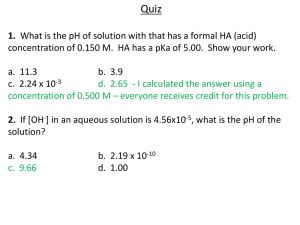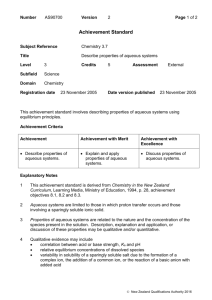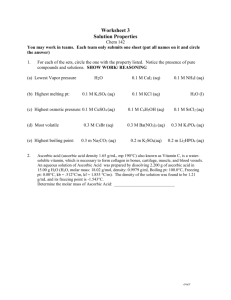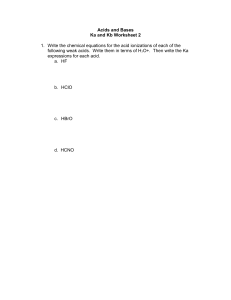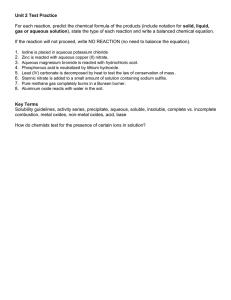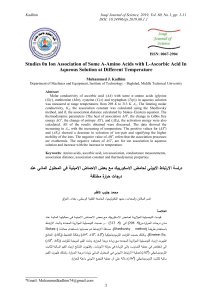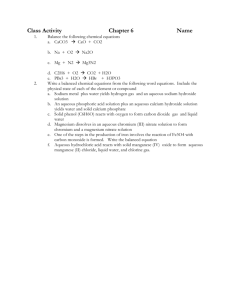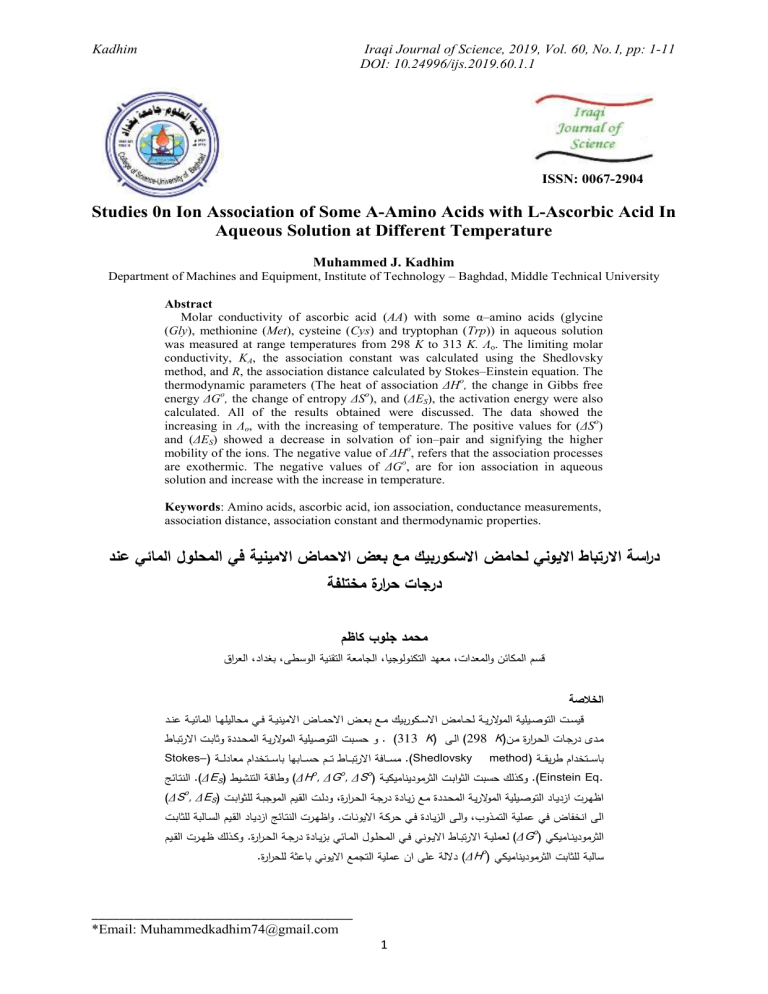
Iraqi Journal of Science, 2019, Vol. 60, No.1, pp: 1-11 DOI: 10.24996/ijs.2019.60.1.1 Kadhim ISSN: 0067-2904 Studies 0n Ion Association of Some Α-Amino Acids with L-Ascorbic Acid In Aqueous Solution at Different Temperature Muhammed J. Kadhim Department of Machines and Equipment, Institute of Technology – Baghdad, Middle Technical University Abstract Molar conductivity of ascorbic acid (AA) with some α–amino acids (glycine (Gly), methionine (Met), cysteine (Cys) and tryptophan (Trp)) in aqueous solution was measured at range temperatures from 298 K to 313 K. Λo. The limiting molar conductivity, KA, the association constant was calculated using the Shedlovsky method, and R, the association distance calculated by Stokes–Einstein equation. The thermodynamic parameters (The heat of association ΔHo, the change in Gibbs free energy ΔGo, the change of entropy ΔSo), and (ΔES), the activation energy were also calculated. All of the results obtained were discussed. The data showed the increasing in Λo, with the increasing of temperature. The positive values for (ΔSo) and (ΔES) showed a decrease in solvation of ion–pair and signifying the higher mobility of the ions. The negative value of ΔHo, refers that the association processes are exothermic. The negative values of ΔGo, are for ion association in aqueous solution and increase with the increase in temperature. Keywords: Amino acids, ascorbic acid, ion association, conductance measurements, association distance, association constant and thermodynamic properties. دراسة االرتباط االيوني لحامض االسكوربيك مع بعض االحماض االمينية في المحلول المائي عند درجات حرارة مختلفة محمد جلوب كاظم العراق، بغداد، الجامعة التقنية الوسطى، معهد التكنولوجيا،قسم المكائن والمعدات الخالصة قيستتت التوصتتيةية المويريتتة ل تتامو ايستتكوربي م ت بع تو اي متتاو ايمينيتتة حتتي م اليةهتتا المائيتتة نتتد و ستبت التوصتيةية المويريتة الم تدد وتابتت ايرتبتاط. (313 K ) التى298 K متد درجتات ال ترار متن Stokes– مس تتاحة ايرتب تتاط ت تتم س تتابها باس تتت دام معادل تتة.)Shedlovsky o o o method باس تتت دام طريق تتة النتتائ.)ΔES ) وطاقتة التنيتيطΔH , ΔG , ΔS سبت التوابتت الترموديناميكيتة o وكذل.)Einstein Eq. )ΔS , ΔES ودلتت القتيم الموجبتة لةتوابتت، اظهترت ادديتاد التوصتيةية المويريتة الم تدد مت ديتاد درجتة ال ترار واظهترت النتتائ ادديتاد القتيم الستالبة لةتابتت. والتى الديتاد حتي ركتة اييونتات،,الى ان فاو حي مةية التمتذو وكتتذل ظهتترت القتتيم.) لعمةيتتة ايرتبتتاط اييتتوني حتتي الم ةتتوئ المتتائي بديتتاد درجتتة ال ترارΔGo الترمودينتتاميكي .) ديلة ةى ان مةية التجم اييوني با تة لة رارΔHo سالبة لةتابت الترموديناميكي _____________________________________ *Email: Muhammedkadhim74@gmail.com 1 Kadhim Iraqi Journal of Science, 2019, Vol. 60, No.1, pp: 1-11 1 Introduction Amino acids are important and essential to all life [1]. They commonly exist as polymers famous as polypeptides and proteins. "Proteins serve as nutrients, regulate metabolism, assist in the absorption of oxygen, and play important roles in the functioning of the nervous system, provide the mechanical basis for muscle contraction, represent a major support material for the body, and assist in the transfer of genetic information [2]. Ascorbic acid (famous as vitamin C) in other side plays significant functions in the human body [3]. So, human tissues contain high concentrations of vitamin C (between 7–70 mg %) [4]. It is necessary for collagen synthesis, the protein that serves numerous connective roles in the body [4–5]. Neuronal ascorbate "content as maintained by this protein also has relevance for human disease, since ascorbate supplements decrease infarct size in ischemia–reperfusion injury- models of stroke, and since ascorbate may protect neurons from the oxidant damage associated with neurodegenerative diseases such as Alzheimer’s, Parkinson’s, and Huntington’s [6]. Production of "certain hormones and neurotransmitters and the metabolism of some amino acids and vitamins require vitamin C. This vitamin also assists the liver in the detoxification of toxic substances in the system, and the blood in fighting infections. Ascorbic acid is important to the proper function of the immune system. As an antioxidant, it reacts with compounds like histamines and peroxides to reduce inflammatory symptoms. Its antioxidant property is associated with the reduction of cancer incidence [5]. So the interaction of proteins and amino acids with ascorbic acid (Figure-1) plays an important functions in biochemical processes [4–7]. Figure 1-L-Ascorbic acid [6]. One of the most interactions is the "ion association", which is commonly used in solution chemistry [8]. As it is well known, there are two distinctive mechanisms for ionic association. The first one of ionic association is chemical association in which there is a true chemical bond. The second mechanism, result from electrostatic association, in which the association process is attributable to strong Columbic interactions, and this is one of the most fundamental atomic interactions in chemistry and biology [9]. Ion pairs (also known as salt bridge) of electrostatically interacting cationic and anionic moieties are important for proteins and nucleic acids to perform their function. Crucial intermolecular ion pairs are often found in the structures of protein–drug complexes, suggesting that deeper knowledge of ion pairs can improve drug design. Despite the fundamental importance of bio molecular ion pairs, it seems that their physicochemical properties are not well known in the molecular biology, structural biology, biophysics, and biochemistry research communities [10]. The concept of ion association, with the formation of solvent separated or contact ion pair, is involved [11]. The transport properties of "mixtures of ionic liquids (conductance, viscosity, and transference numbers) are important because the values provide useful and sensitive information about ion–solvent interaction, ionic association, and solvent structure [12, 13]. The present work reports the comparative studies of conductance measurements, association distance, association constant and, thermodynamic properties for ion association of ascorbic acid with some α–amino acids in aqueous solution at temperatures ranges from 298–313 K. 2 Kadhim Iraqi Journal of Science, 2019, Vol. 60, No.1, pp: 1-11 2 Experimental Ascorbic acid (AA), glycine (Gly), methionine (Met), cysteine (Cys), and tryptophan (Trp) amino acids were purchased from "Merch" with purity at 99.9 %. Deionized water used in preparation of solutions have specific conductance in the range of (2– 3×10−6 S/cm). Solvent densities, ρo, viscosities, η, and relative permittivity, εr, are represented in Table-1. The specific conductivities were measured by digital conductivity bridges with a dip type immersion conductivity cell were used. All the solutions of ascorbic acid and amino acids were prepared at different concentrations (2–5×10-3 mol/L) with carefully upon preparation by dissolving required quantity of the sample in conductivity water. Conductivity measurements were done at the temperature range (298–313 K), under control by using water bath and thermometer. The measurements of mass using in preparation of solutions were done by using (Sartorius RC 210D) an analytical balance. 3 Results and discussion 3.1 Conductance of aqueous solution for ascorbic acid: amino acids at different temperatures. Many chemical reactions require a suitable solvent. Water is the solvent of choice in inorganic chemistry [14], has an imperative role in biological environments, and it's basic to all life. A few basic "interactions are responsible for holding proteins together. The properties of water are intimately involved in these interactions. Polar amino acid chains can participate in hydrogen bonding to water, or hydrophobic side chains can interfere with it. Neutral polar side chains are uncharged, but they have groups (–OH, –SH, NH, CO) that can hydrogen-bond to water. In an unfolded protein, these residues are hydrogen-bonded to water. They prefer to be exposed to water, but if they are found in the protein interior they are hydrogen-bonded to other polar groups. On the surface of the protein, a charged residue can be solvated by water, and it is easy to separate oppositely charged ions because of the high dielectric constant of water [15]. The interaction of proteins and amino acids with ascorbic acid plays an important role in biochemical processes, and because the "structural complexity of proteins, direct thermodynamic study is quite difficult. So the low molecular weight model compounds such as amino acids are studied [8]. The numerous papers [4–7] study the relation between proteins and amino acids with ascorbic acid doesn’t reports a study of conductance measurements, association constant and, thermodynamic properties for ion association of ascorbic acid with α–amino acids in aqueous solution. The predominate state of amino acids and ascorbic acid in neutral solution can be represented in Scheme-1. Scheme-1: A: L-α-amino acid at pKa= 2 to pKa= 9 [16], B: L-Ascorbic acid at pKa= 4 to pKa= 14 [17]. The physical properties of distilled water are given in Table-1 as reported in literature [18,19]. Table 1-Densities, ρo, viscosities, η, and relative permittivity, εr, of conductivity water at different temperatures T/K ρo / g m-3 η /g m-1s-1 εr 892 0.9971 0.8903 78.30 303 0.9957 0.7974 76.55 302 0.9941 0.7194 74.83 313 0.9923 0.6531 73.15 3 Kadhim Iraqi Journal of Science, 2019, Vol. 60, No.1, pp: 1-11 The conductivity measured as specific conductivity к, and converts to molar conductivity Λ, by using the following relation: The affinity between different charge ions is measured by association constant. So the conductivity data were analyzed for 1:1 ascorbic acid to amino acids in aqueous solution uses set of equations. Associations constant were calculated from the conductance data by using Shedlovsky method (Eq. 2) [11,20]. Where Λ, is the molar conductance, Λo, is the limiting molar conductance, C, is the concentration of solution, , is the activity coefficient of the free ions, γ, is the degree of dissociation, KA, is the observed association constant and , is the mean activity coefficient of the free ions which calculated using equation 3: Where: R, is the maximum center to center distance between ions in the ion pair association, D, is the dielectric constant, η, is the viscosity (g m-1s-1), and T, is the temperature in K. The degree of dissociation γ, in case of S (Z) can be given by: The result from (Eq. 2) compared with Fuoss–Kraus equation (Eq. 6) [21], and, the result is very iterative. The electrostatic radius for positive and negative diffusing species ions ( using Stokes–Einstein equation (Eq. 7) [22]. ) can be calculated by Where D, is the diffusion coefficient, k, is the Boltzmann constant, T, is the temperature in Kelvin, η, is the dynamic viscosity, and , is the hydrodynamic radius of the diffusing species. The diffusion coefficient values of diffusing species ascorbic acid and tryptophan [23], glycine [24], methionine [25], and cysteine [26] represent in Table–2 as reported in literature, and the radius of the diffusing species , results from Stokes–Einstein equation are shown in Table–3. 4 Kadhim Iraqi Journal of Science, 2019, Vol. 60, No.1, pp: 1-11 Table 2-Values of diffusion coefficients, D /10-9 m2/s, of ascorbic acid and amino acids in aqueous solution D/ 10-9 m2s-1 T/K AA Gly Met Cys Trp 298 0.68 1.00 0.57 0.78 0.66 303 0.83 1.30 0.72 0.93 0.81 308 0.98 1.45 0.86 1.10 0.97 313 1.14 1.59 1.00 1.30 1.10 Table 3-Radius of the diffusing species, aqueous solution /angstrom (Ao), of ascorbic acid and amino acids in R/ Ao T/K 298 303 308 313 AA 3.66 3.40 3.24 3.12 Gly 2.50 2.30 2.20 2.20 Met 4.30 3.90 3.70 3.60 Cys 3.20 3.00 2.90 2.70 Trp 3.70 3.40 3.28 3.24 As shown in Scheme-1, the amino acid (at pH between 2 and 9) contains both a positive αammonium and a negative carboxylate group [16], so the conductivity is very little. For this reason, the conductivity of the ascorbic acid solution (Table-4) was taken for a comparative with the conductivity of ion association between amino acids and ascorbic acid. Table 4-The molar conductivity, Λ/Scm2mol-1, of ascorbic acid in aqueous solution at different temperature T/ K AA 892 303 302 313 C×10-3 M Λ Λ Λ Λ 8 256 259 261 262 3 224 225 227 229 4 204 206 207 208 5 185 186 187 188 The molar conductivity, Λ, of 1:1 ascorbic acid: amino acids in aqueous solution at different temperature are listed in Tables–(5–8). The limiting molar conductivity, Λo, can be calculated by linear extrapolation from the plot of molar conductivity, Λ, versus the square root of the molar concentration, C1/2 [11, 27] as showed in the Figure below. Figure 2-The plot of molar conductivity, Λ, versus C1/2 for ascorbic acid: glycine in aqueous solution at 298 K. 5 Kadhim Iraqi Journal of Science, 2019, Vol. 60, No.1, pp: 1-11 Table 5-The molar conductivity, Λ/Scm2mol-1, of 1:1 ascorbic acid: glycine in aqueous solution at different temperature T/ K Gly. 892 303 302 313 -3 C×10 M Λ Λ Λ Λ 8 228 230 233 235 3 199 201 203 205 4 175 176 178 179 5 159 160 161 162 Table 6-The molar conductivity, Λ/Scm2mol-1, of 1:1 ascorbic acid: cysteine in aqueous solution at different temperature T/ K Cys. 892 303 302 313 -3 C×10 M Λ Λ Λ Λ 8 175 172 121 123 3 147 149 151 153 4 131 138 133 134 5 119 180 181 188 Table 7-The molar conductivity, Λ/Scm2mol-1, of 1:1 ascorbic acid: methionine in aqueous solution at different temperature T/ K Met. 892 303 302 313 C×10-3 M Λ Λ Λ Λ 8 232 834 835 832 3 802 810 811 818 4 120 128 183 124 5 168 163 164 165 Table 8-The molar conductivity, Λ/Scm2mol-1, of 1:1 ascorbic acid: tryptophan in aqueous solution at different temperature T/ K Trp. 892 303 302 313 C×10-3 M Λ Λ Λ Λ 8 157 159 161 170 3 134 135 137 132 4 117 112 119 180 5 106 107 102 110 Association distance (distance parameter) R, is the distance between center–to–center for the ions in the formed of ion-pair, and calculated as the summation of cation and anion radii in angstrom (Ao) in addition to diameter of water molecule (equal to 2.80 Ao) [28]. The observed association constant, KA, the limiting molar conductivity, Λo, and the distance of the association, R, are shown in Tables-(9-18). Table 9-The limiting molar conductivity, Λo/ S cm2 mol-1, observed association constant, KA/dm3mol-1, and hydrodynamic radius of ion pair association, R/Ao, of 1:1 ascorbic acid: glycine in aqueous solution at different temperature. Gly T/ K 893 303 303 313 Λo 377 378 380 382 KA 169 165 162 160 R 8.96 8.50 8.24 8.12 6 Kadhim Iraqi Journal of Science, 2019, Vol. 60, No.1, pp: 1-11 Table 10-The limiting molar conductivity, Λo/ S cm2 mol-1, observed association constant, KA/ dm3 mol-1, and hydrodynamic radius of ion pair association, R/ Ao, of 1:1 ascorbic acid: cysteine in aqueous solution at different temperature Cys T/ K 893 303 303 313 Λo 380 383 386 382 KA 837 831 887 884 R 9.66 9.20 8.94 8.62 Table 11-The limiting molar conductivity, Λo/ S cm2 mol-1, observed association constant, KA/ dm3 mol-1, and hydrodynamic radius of ion pair association, R/ Ao, of 1:1 ascorbic acid: methionine in aqueous solution at different temperature. Met T/K 893 303 303 313 Λo 325 327 390 398 KA 178 170 162 167 R 10.76 10.10 9.74 9.52 Table-12: The limiting molar conductivity, Λo/ S cm2 mol-1, observed association constant, KA/ dm3 mol-1, and hydrodynamic radius of ion pair association, R/ Ao, of 1:1 ascorbic acid: tryptophan in aqueous solution at different temperature. Trp T/K 893 303 303 313 Λo 875 877 872 821 KA 806 808 197 171 R 10.16 9.60 9.32 9.16 The ascorbic acid solution appear rising in molar conductivity relative to the conductivity of amino acids with ascorbic acids solution (as shown in Tables 4-8). This indicates that the ion association is taken place. The values of Λ, for these solutions retain the relation: AA ˃ Met ˃ Gly ˃ Cys > Trp. From Tables-(9-12), it is shown that Λo, values increase for ion association as the temperature increase, and the same trend is seen for KA, values. The increase of Λo, with increasing of temperature, is due to the decrease of solvent viscosity [28], and higher mobility or a reduced amount of solvation of the ions in aqueous solution. This is owing to the fact that the growth thermal energy effects in greater bond breaking and also leads to higher mobility and higher frequency of ions because of variant in translational, rotational, and vibrational energy of molecules [29]. Both conductance and diffusion include movement of ions, and therefore, a connection between them will be exist [30]. So the radius of ion association is decrease as temperature increase (and as the diffusion coefficient increase), and the association distance (R/Ao) takes a sequence Met˃Trp> Cys> Gly. The values of KA, for studied solutions retain the relation Cys ˃ Trp > Met > Gly at all temperatures. 3.2 Thermodynamic functions measurements of ascorbic acid: amino acids in aqueous solution: The activation energy (ΔES), (which is defined in a chemical system as the amount of energy available for a reaction to take place) can be calculated from equation of S. A. Arrhenius (Eq. 8) [12]. Where: R, ideal gas constant, A, Arrhenius factor, ΔES, Arrhenius activation energy, and T, is the temperature. By plotting a graph between ( logΛo) and (1/ T), straight line is obtained as displayed in Figure-3, with slope equal to (−ΔES/ 2.303R) from which ΔES value can be calculated. As shown, ΔES, has a positive value which points to the high mobility of ions in the solution and thus high Λo values. 7 Kadhim Iraqi Journal of Science, 2019, Vol. 60, No.1, pp: 1-11 Figure 3-The plot of log Λ as a function of 1/ T for ascorbic acid: Glycine in aqueous solution. The heat of association ΔHo, (or the standard enthalpy of formation refers to the enthalpy change when one mole of a compound is formed from its elements) calculated by applying Van't Hoff's expression (Eq. 9) [12]. The ΔHo, value results from (−ΔHo/2.303R), the slope that obtained by a plot of a graph between log KA, and 1/ T, as shown in Figure bellow. Figure 4-The plot of log KA as a function of 1/ T for Ascorbic acid: Glycine in aqueous solution at different temperature. The change in Gibbs free energy ΔGo, (a measure of usable energy in the system) throws the association process is obtained from (Eq. 10) [8]. Gibbs-Helmholtz equation (Eq. 11) [8] was used to estimate the change of entropy, ΔSo, (the state function that gives a measure of disorder or randomness). The data result from equation (8-11) can be shown in Tables-(13-16). 8 Kadhim Iraqi Journal of Science, 2019, Vol. 60, No.1, pp: 1-11 Table 13-Thermodynamic parameters: ΔGo (KJ mol-1), ΔSo (J K-1mol-1), ΔHo (KJ mol-1), and ΔEs (KJ mol-1), of 1:1 ascorbic acid: glycine in aqueous solution at different temperature. Gly T/K ΔGo ΔSo ΔHo ΔEs 893 -13.50 38.70 303 -13.70 38.70 303 -13.96 42.30 313 -14.21 39.10 -1.98 +1.92 Table 14-Thermodynamic parameters: ΔGo (KJ mol-1), ΔSo (J K-1mol-1), ΔHo (KJ mol-1), and ΔEs (KJ mol-1), of 1:1 ascorbic acid: cysteine in aqueous solution at different temperature. Cys T/K 893 303 303 313 o ΔG -12.50 -13.05 -13.31 -13.56 ΔSo 32.85 34.13 34.42 34.67 ΔHo -2.71 ΔEs +2.59 Table 15-Thermodynamic parameters: ΔGo (KJ mol-1), ΔSo (J K-1mol-1), ΔHo (KJ mol-1), and ΔEs (KJ mol-1), of 1:1 ascorbic acid: methionine in aqueous solution at different temperature. Met T/K 893 303 303 313 ΔGo -13.49 -13.74 -13.98 -14.24 ΔSo 39.10 39.27 39.42 39.62 ΔHo -1.84 ΔEs +0.66 Table 16-Thermodynamic parameters: ΔGo (KJ mol-1), ΔSo (J K-1mol-1), ΔHo (KJ mol-1), and ΔEs (KJ mol-1), of 1:1 ascorbic acid: tryptophan in aqueous solution at different temperature. Trp T/ K 893 303 303 313 ΔGo -12.53 -12.77 -13.01 -13.36 ΔSo 28.96 29.27 29.58 30.22 o ΔH -3.90 ΔEs +1.94 From Tables-(13-16) the result data show that: The activation energy ΔES, is a positive result for the ion association in aqueous solution and this signifying that higher mobility of the ions in aqueous solution and therefore a higher Λo, values. The values of ΔGo, decrease with increase in temperature. The decrease in ΔGo, values for the ion association in aqueous solution to fewer values at rising temperature favoritisms the transfer of the free solvent molecules to the bulk solvent and this indication to a reduced ΔGo values. The values of ΔGo, are negative for the ion association in aqueous solution. This indicates that the association is favorite rather than the dissociation process in aqueous solution. The parameter ΔHo, shown negative values in aqueous solution, and this refers that the interaction between ions with a negative values to exothermic association processes in nature but the value is very small. A positive ΔSo, values indicate an increase in disorder of ions in aqueous solution, because of reduction in the solvation of ion-pair related to that of the free ion. This can be due to increase in the freedom degree throw association processes, and this is because the freedom of solvent molecules [12, 28, 29]. 4 Conclusions Molar conductivity of ascorbic acid with some α–amino acids in aqueous solution has been reported at T = 298 to 313 K. The limiting molar conductivity Λo, and the association constant KA, are calculated using the Shedlovsky method. The association distance R, calculated by Stokes–Einstein 9 Kadhim Iraqi Journal of Science, 2019, Vol. 60, No.1, pp: 1-11 equation. The data indicate that Λo, values increase for ion association as the temperature increase, and the same trend is seen for KA, values. The increase of Λo, with an increase of temperature is due to the decrease of solvent viscosity [28], and higher mobility or a reduced amount of solvation of the ions in aqueous solution. This is owing to the fact that the growth thermal energy effects in greater bond breaking and also lead to higher mobility and higher frequency of ions because of variant in translational, rotational, and vibrational energy of molecules [29]. Both conductance and diffusion include movement of ions, and therefore, a connection between them will be exist [30]. So the radius of ion association is decrease as temperature increase (and as the diffusion coefficient increase). ΔHo, ΔGo, ΔSo, the thermodynamic parameters and ΔES, the activation energy also calculated. ΔES, is a positive result for the ion association in aqueous solution and this signifying that higher mobility of the ions in aqueous solution. The values of ΔGo, decrease with increase in temperature for the ion association in aqueous solution because of transfer of the free solvent molecules to the bulk solvent. The values of ΔGo, are negative to indicate that the association is favorite rather than the dissociation process in aqueous solution. The parameter ΔHo, shown small negative values in aqueous solution refer to exothermic association processes in nature, and this can be caused by the interaction between ions. A positive ΔSo, values indicate an increase in randomness of ions in aqueous solution, because of reduction in the solvation of ion-pair related to that of the free ion, and this is because the free solvent molecules [12, 28, 29]. References 1. Guoyao, W. 2010. Functional Amino Acids in Growth: Reproduction, and Health, American Society for Nutrition, Adv. Nutr., 1: 31–37. 2. EI-Sharkawy, A.A., Dakroury A.Z. and Osman, M.B.S. 1992. Thermal Properties of Some α– Amino Acids in Aqueous Solutions, International Journal of Thermophysics, 13(5): 827–831. 3. Ghazoyan, H.H. and Markarian, Sh. A. 2018. Densities and Volumetric Properties of L–Ascorbic Acid Solutions in Water-Ethanol Mixtures at Temperatures from 298.15 to 318.15 K, Chemistry and Biology, 52(1): 3–9. 4. Juliet, M.P., Anitra, C.C. and Margreet, C.M.V. 2017. The Roles of Vitamin C in Skin Health, Nutrients, 9(866):1–7. 5. Walingo, K.M. 2005. Role of Vitamin C (Ascorbic Acid) on Human Health: A Review, African Journal of Food Agriculture and Nutritional Development (AJFAND), 5(1): 1–7 6. May, J.M. 2012. Vitamin C Transport and Its Role in The Central Nervous System, Subcell Biochem, 56: 85–103. Doi: 10.1007/978-94-007-2199-9-6 7. Savini, I., Rossi, A., Pierro, C., Avigliano L. and Catani, M.V. 2008. SVCT1 and SVCT2: Key Proteins for Vitamin C Uptake, Amino Acids, 34: 347–355. 8. Das, S. and Dash, U.N. 2013. Ion Association of Glycine, α-Alanine and β-Alanine in Water and Water+ D–Glucose Mixtures at Different Temperatures, Journal of Applied Pharmaceutical Science, 3 (9): 060–064. Doi: 10.7324/JAPS.2013.3911 9. Nikos, G.T. and Ioanna, E.M. 2007. Conductivity Studies of N–Tetra butyl ammonium Tetra phenyl borate in 3-Pentanone in the Temperature Range from 283.15 to 329.15K, J. Solution Chem., 36: 153–170. 10. Junji, I., Alexandre, E. and Levani, Z. 2015. Physico-chemical Properties of Ion Pairs of Biological Macromolecules, Biomolecules, 5: 2435–2463. 11. Akrawi, B.A.M. 1981. The Analysis of Conductance Data for Single and Mixed Electrolyte Solutions, Ph.D. Thesis, Electro–analytical Chemistry, University of Surrey. 12. El–Hammamy, N.H. and El–Araby, H.A. 2016. Electrical Conductivity and Thermodynamic Studies on Sodium Diethyldithiocarbamate in Methanol at Different Temperatures, Int. J. Electrochem. Sci., 11: 8709–8721. Doi: 10.20964/2016.10.23 13. Mohondas, S.N. and Lalrosanga, Michael L. 2012. Ion Pair Formation of Hexamine Nickel (II) Chloride and Tris–Ethylene Diamine Nickel (II) Chloride in Aqueous Medium at Different Temperatures, RJPBCS, 3(3): 1–7. 14. Pass G. and Sutcliffe H. 1974. Practical Inorganic Chemistry, 2nd Edition, Springercience+Business Media, B.V., 122 P. 01 Kadhim Iraqi Journal of Science, 2019, Vol. 60, No.1, pp: 1-11 15. Gilbert, H.F. 2000. Basic Concepts in Biochemistry: A Student's Survival Gu-ide, 2nd Edition, MC Graw-Hill. USA, 8 P. 16. Hegyi G., Kardos J., Csizmadia A.M., Nyitray L., Pál G., Radnai L., Reményi A. and Venekei I. 2013. Introduction to Practical Biochemistry, Eötvös Loránd University, 30 P. 17. Yi, J.T., David, N. and Schlegel H.B. 2017. A Theoretical Study of Ascorbic Acid Oxidation and HOO•/O2•− Radical Scavenging, Org. Biomol. Chem., 15: 4417–4431. 18. Malmberg, C.G. and Maryott A.A. 1956. Dielectric Constant of Water from 0 to 1000 C, Journal of Research of the National Bureau of Standards, 56(I): 1–8. 19. Joseph, K., Mordechai, S. and William, A.W. 1978. Viscosity of Liquid Water in The Range –8 C to 150 C, J. Phys. Chem. Ref. Data, 7(3): 941–948. 20. Ajoy, M., Ashis, N., Mohan, P. and Sanjib, B. 1994. Ionic Association and Ion–Solvent Interactions: Conductance of N–ethyl–4–cyanopyridinium iodide in ethanol–water mixtures, Indian Journal of Chemistry, 33A: 297–302. 21. Raymond, M. F. 1978. Paired ions: Dipolar pairs as subset of diffusion pairs, Proc. Natl. Acad. Sci. USA, 75(1): 16–20. 22. Yuri, C., Dagny, A.U., Erin, E., Lindsay, R.W., Saeid, K. and Allan, K.B. 2017. Diffusion coefficients of organic molecules in sucrose–water solutions and comparison with Stokes–Einstein predictions, Atmos. Chem. Phys., 17: 2423–2435. 23. Gongwei, Z., Zhen, L. and Congxiang, W. 1997. Flow injection analysis methods for determination of diffusion coefficients, Analytica Chimica Acta, 350 (3): 359–363. 24. Jacques, B., Zeshi, Z. and Konstantin, S. 2007. Metal Flux and Dynamic Speciation at (Bio) Interfaces, Part I: Critical Evaluation and Compilation of Physicochemical Parameters for Complexes with Simple Ligands and Fulvic/Humic Substances, Environ. Sci. Technol., 41(22): 7609–7620. 25. Jahan, B.R., Reza, O., Hadi, B. and Rahman, H. 2006. Electrocatalytic Oxidation and Highly Selective Voltammetric Determination of L–Cysteine at The Surface of a 1– [4– (Ferrocenyl ethynyl) phenyl] –1–ethanone Modified Carbon Paste Electrode, Analytical Sciences, 22: 1213– 1220. 26. Tan, W.T. and Goh, J.K. 2008. Electrochemical Oxidation of Methionine Mediated by a Fullerene–C60 Modified Gold Electrode, Electroanalysis, 20(22): 2447–2453. 27. Dani, M., Cherupally, K.K.N., Jasmin, A.J., Nandita, B., Tulsi, M., Sudhir, K. and Tsutomu, V.K. 2007. Ascorbic Acid Mono–glucoside as Antioxidant and Radioprotector, J. Radiat. Res., 48: 369– 376. 28. Vesna, S., Ivo, T., Renato, T. and Marija, V. 2005. Thermodynamics of the Association Reaction of Li+ and Br– Ions in 2–Butanol + Water Mixtures from Conductivity Measurements, Croatica Chemica Acta, 78(1): 43–47. 29. El–Hammamy, N.H., El–Hammamy, M.N. and Kawana, A.I. 2014. Thermodynamic Studies of Ion Association of s–Acetylthiocholine Halides and Perchlorate in Methanol Solutions, J. Mex. Chem. Soc., 58(1): 11–15. 30. Stephen, K. and Howard, D.D. 1996. Evaluation of Diffusion Coefficients of Metallic Ions in Aqueous Solutions, Electrounulysrs, 8(4): 307–313. 00
